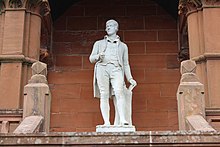
Nelson's Column is a monument in Trafalgar Square in the City of Westminster, Central London, built to commemorate Vice-Admiral Horatio Nelson's decisive victory at the Battle of Trafalgar over the combined French and Spanish navies, during which he lost his life, killed by a French sniper. The monument was constructed between 1840 and 1843 to a design by William Railton at a cost of £47,000. It is a column of the Corinthian order built from Dartmoor granite. The statue of Nelson was carved from Craigleith sandstone by sculptor Edward Hodges Baily. The four bronze lions around its base, designed by Sir Edwin Landseer, were added in 1867.
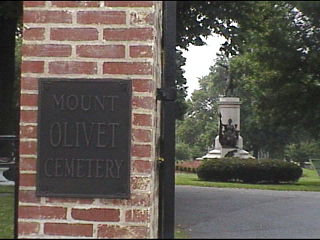
Mount Olivet Cemetery is a cemetery in Frederick, Maryland. The cemetery is located at 515 South Market Street and is operated by the Mount Olivet Cemetery Company, Inc.
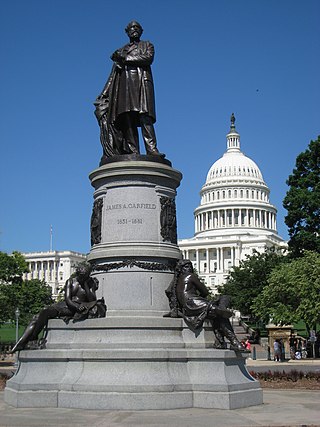
The James A. Garfield Monument stands on the grounds of the United States Capitol in the traffic circle at First Street and Maryland Avenue SW in Washington, D.C. It is a memorial to U.S. President James A. Garfield, who was elected in 1880 and assassinated in 1881 after serving only four months of his term. The perpetrator was an attorney and disgruntled office-seeker named Charles J. Guiteau. Garfield lived for several weeks after the shooting, but eventually succumbed to his injuries. The monument is part of a three-part sculptural group near the Capitol Reflecting Pool, including the Peace Monument and the Ulysses S. Grant Memorial in Union Square. The monument is also a contributing property to the National Mall and L'Enfant Plan, both of which are listed on the National Register of Historic Places and the District of Columbia Inventory of Historic Sites. The bronze statue rests on a granite pedestal that features three sculptures, each one representing a time period in Garfield's life.

The TitanicMemorial is a granite statue in Southwest Waterfront neighborhood of Washington, D.C., that honors the men who gave their lives so that women and children might be saved during the sinking of the Titanic. Ten days after the sinking on April 25, 1912, a group of women formed a committee to raise money for a memorial to honor the sacrifice, with a limit of $1 per person. After sending thousands of cards to other women throughout the U.S., the funds the committee had raised alongside funding from the federal government was enough to complete the project. A competition was announced for a memorial design and several were submitted. The winning design by Gertrude Vanderbilt Whitney, who later opened the Whitney Museum of American Art, became her first major commission.

The Burns Monument in Kay Park, Kilmarnock, Scotland, commemorates the poet Robert Burns (1759–1796). It is located at an elevated position within Kay Park, to the east of Kilmarnock Town Centre. The monument was opened in 1879, and is a category B listed building. In 2004, following years of neglect by the local council, fire destroyed most of the building. What was left of the monument was incorporated into the new Burns Monument Centre which opened in 2009. In 2010 the centre was shortlisted for the Carbuncle Cup award run by Building Design.

The Robert Burns Memorial, created by sculptor George Anderson Lawson, is a monument located at Dorchester Square in Downtown Montreal.

The Luther Monument is a public artwork located in front of Luther Place Memorial Church in Washington, D.C., United States. The monument to Martin Luther, the theologian and Protestant Reformer, is a bronze, full-length portrait. It is a copy of the statue created by Ernst Friedrich August Rietschel as part of the 1868 Luther Monument in Worms, Germany. The version in Washington, D.C., inspired the installation of many other castings across the U.S. The statue is a contributing property to the Luther Place Memorial Church's listing on the National Register of Historic Places (NRHP) and District of Columbia Inventory of Historic Sites (DCIHS). It is also a contributing property to the Greater Fourteenth Street Historic District, which is also listed on the NRHP and DCIHS.
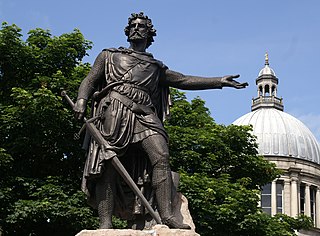
William Grant Stevenson, was a Scottish sculptor and portrait painter.

The General William Tecumseh Sherman Monument is an equestrian statue of American Civil War Major General William Tecumseh Sherman located in Sherman Plaza, which is part of President's Park in Washington, D.C., in the United States. The selection of an artist in 1896 to design the monument was highly controversial. During the monument's design phase, artist Carl Rohl-Smith died, and his memorial was finished by a number of other sculptors. The Sherman statue was unveiled in 1903. It is a contributing property to the Civil War Monuments in Washington, D.C. and to the President's Park South, both of which are historic sites listed on the National Register of Historic Places.

The Robert Burns Memorial is a granite monument located in downtown Barre, Vermont. It was erected by Barre's Scottish immigrants in 1899 to commemorate the centenary of the death of Scottish poet Robert Burns.

The statue of Robert Burns in Milwaukee, Wisconsin, is a work of public art by the Scottish artist William Grant Stevenson, RSA. The statue is a memorial to the world renowned poet, bard, and Scotsman Robert Burns. The bronze statue stands upon a plinth of Nova Scotia pink granite. The plinth is adorned with two bronze bas relief panels depicting scenes from Burns' poetry. The monument was donated to the City of Milwaukee by James A. Bryden.

The Robert Burns World Federation is a literary society based in Kilmarnock, Ayrshire, Scotland, aimed at educating the public about the life, poetry and works of the poet Robert Burns. It is a Scottish Charity and a company limited by Guarantee. The Federation links existing Burns Clubs and similar groups, giving a unique number to affiliated Clubs, which is then used by them in their promotion and identification. Their ongoing intent is to provide a way for clubs to link together and enjoy the mutual benefit of association, communication and shared mission. It was founded in 1885

A bronze statue of Isambard Kingdom Brunel, also known as Brunel Monument or the Isambard Brunel Monument, by Carlo Marochetti, stands on the Victoria Embankment in London, England, at the west end of Temple Place. The statue rests on a Portland stone pedestal, with flanking screens and benches, by the architect Richard Norman Shaw.

The Melville Monument is a large column in St Andrew Square, Edinburgh constructed between 1821 and 1827 as a memorial to Scottish statesman Henry Dundas, 1st Viscount Melville.

The J. E. B. Stuart Monument is a deconstructed monument to Confederate general J. E. B. Stuart at the head of historic Monument Avenue in Richmond, Virginia, which was dedicated in 1907. The equestrian statue of General Stuart was removed from its pedestal and placed into storage on July 7, 2020 after having stood there for 113 years. The removal was in response to nationally reported events of police brutality and a corresponding emergency declaration in Virginia. The granite pedestal, which stood empty for nineteen months, was finally dismantled in February 2022.
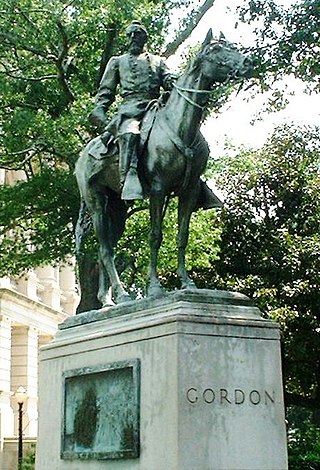
The equestrian statue of John Brown Gordon is a monument on the grounds of the Georgia State Capitol in Atlanta, Georgia, United States. The monument, an equestrian statue, honors John Brown Gordon, a general in the Confederate States Army during the American Civil War who later become a politician in post-Reconstruction era Georgia. Designed by Solon Borglum, the statue was dedicated in 1907 to large fanfare. The statue has recently become a figure of controversy over Gordon's racist views and associations with the Confederacy, with some calling for its removal.

"Dutchy" is the nickname of a Confederate monument in Elberton, Georgia. Unveiled in 1898, the statue was criticized for its poor design, and in 1900 the statue was toppled and buried by townspeople. The statue was later unearthed in 1982 and currently is on display in a local museum.
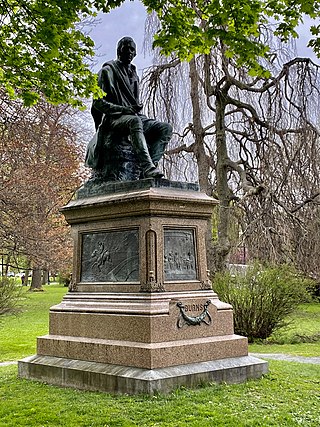
A statue of Robert Burns stands in Washington Park in Albany, New York, United States. The statue was designed by Charles Calverley and was unveiled in 1888. Four bas-reliefs around its pedestal, in part designed by George Henry Boughton, were later added in 1891. The statue is one of the oldest pieces of public art in the park.

The Jubilee Memorial, Harrogate, is a Grade II listed building. It is a Gothic Revival stone memorial in Harrogate, North Yorkshire, England, commemorating the 1887 golden jubilee of Queen Victoria. It was donated to Harrogate by its mayor, Richard Ellis, designed by architect Arthur Bown, and unveiled by the Marquis of Ripon.


